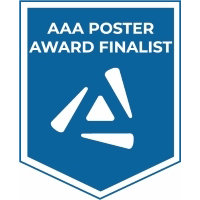Back
ANATOMY
Category: Anatomy
Session: 782 Anatomy: Musculoskeletal
(782.11) Massage application to increase the spread of local anesthesia in sciatic nerve blocks: A cadaveric study
Tuesday, April 5, 2022
10:15 AM – 12:15 PM
Location: Exhibit/Poster Hall A-B - Pennsylvania Convention Center
Poster Board Number: C61
Introduction: AAA has separate poster presentation times for odd and even posters.
Odd poster #s – 10:15 am – 11:15 am
Even poster #s – 11:15 am – 12:15 pm
Introduction: AAA has separate poster presentation times for odd and even posters.
Odd poster #s – 10:15 am – 11:15 am
Even poster #s – 11:15 am – 12:15 pm
Taylor Robertson (University of North Texas Health Science Center), Cara Fisher (University of North Texas Health Science Center), Emma Handler (University of North Texas Health Science Center), Daniel Nash (Bone and Joint Hospital at St. Anthony)
Taylor Robertson
Presenting Author
University of North Texas Health Science Center
Presenting Author(s)
Introduction: Sciatic nerve blocks are essential for surgical treatment of various lower limb pathologies. Due to the complexity and variation of anatomical landmarks, ultrasound (US) guided injection of local anesthesia has become common practice. In patients with thicker thigh girth (i.e., obese patients) excess tissue may distort US penetration thereby diminishing efficacy of the nerve block and/or cause severe post-operative pain. Dye tracing techniques have been used to test the effectiveness of nerve blocks, but there is little research on using massage to manipulate anesthetic spread. Therefore, the aim of this study is to assess the effects of massage to manipulate local anesthesia spread in sciatic nerve blocks. We hypothesize massaging after injection will increase the spread of local anesthesia compared to non-massage post injection.
Methods: Forty un-fixed cadaveric legs were injected with a mixture of methylene blue dye and 2% Lidocaine Hydrochloride. Specimens were divided into non-massage (control) (n=20) and massage (n=20) groups. Sciatic nerve blocks were performed by a nurse anesthetist using US guidance at the popliteal fossa traveling proximally until the sciatic nerve was identified and the location was tagged. Immediately following, massage group specimens received five repeated proximally directed massages with the US transducer head. Specimens from both groups were then dissected to expose the sciatic nerve. Measurements of the distance traveled from marked site of injection to proximal end of dyed area were measured and compared.
Results: Spread of local anesthesia in the inferior-superior direction was significantly higher in the massage group than the control group (p≤0.05).
Conclusions: Massaging post-injection caused a greater spread of local anesthesia during sciatic nerve block.
Significance: Sciatic nerve block techniques often utilize nerve stimulation to identify the sciatic nerve location. This may be due to lack of US penetration through the gluteus maximus muscle. In patients with thicker thigh girth due to subcutaneous fat, imaging visibility may be more difficult as well. Our findings suggest that clinicians may block the sciatic nerve at a more distal location with US guidance and manipulate the anesthesia to the region of interest.
Methods: Forty un-fixed cadaveric legs were injected with a mixture of methylene blue dye and 2% Lidocaine Hydrochloride. Specimens were divided into non-massage (control) (n=20) and massage (n=20) groups. Sciatic nerve blocks were performed by a nurse anesthetist using US guidance at the popliteal fossa traveling proximally until the sciatic nerve was identified and the location was tagged. Immediately following, massage group specimens received five repeated proximally directed massages with the US transducer head. Specimens from both groups were then dissected to expose the sciatic nerve. Measurements of the distance traveled from marked site of injection to proximal end of dyed area were measured and compared.
Results: Spread of local anesthesia in the inferior-superior direction was significantly higher in the massage group than the control group (p≤0.05).
Conclusions: Massaging post-injection caused a greater spread of local anesthesia during sciatic nerve block.
Significance: Sciatic nerve block techniques often utilize nerve stimulation to identify the sciatic nerve location. This may be due to lack of US penetration through the gluteus maximus muscle. In patients with thicker thigh girth due to subcutaneous fat, imaging visibility may be more difficult as well. Our findings suggest that clinicians may block the sciatic nerve at a more distal location with US guidance and manipulate the anesthesia to the region of interest.

